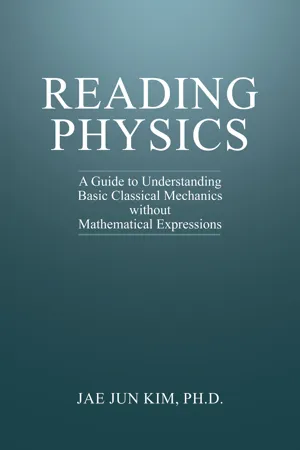Physics
Geometric Rotation
Geometric rotation refers to the transformation of an object around a fixed point in a plane. It involves rotating the object by a certain angle about the center of rotation. This concept is fundamental in understanding the behavior of physical systems, such as the motion of planets, gyroscopes, and other rotating objects.
Written by Perlego with AI-assistance
Related key terms
4 Key excerpts on "Geometric Rotation"
- eBook - ePub
Newtonian Dynamics
An Introduction
- Richard Fitzpatrick(Author)
- 2021(Publication Date)
- CRC Press(Publisher)
CHAPTER 8 Rotational MotionDOI: 10.1201/9781003198642-88.1 Introduction
Up to now, we have only analyzed the dynamics of point masses (i.e., objects whose spatial extent is either negligible, or plays no role in their motion). Let us now broaden our approach in order to take extended objects into account. The only type of motion that a point mass object can exhibit is translational motion; that is, motion by which the object moves from one point in space to another. However, an extended object can exhibit another, quite distinct, type of motion by which it remains located (more or less) at the same spatial position, but constantly changes its orientation with respect to other fixed points in space. This new type of motion is called rotation. Let us investigate rotational motion.8.2 Rigid Body Rotation
Consider a rigid body executing pure rotational motion (i.e., rotational motion that has no translational component). It is possible to define an axis of rotation (which, for the sake of simplicity, is assumed to pass through the body); this axis corresponds to the straight-line that is the locus of all points inside the body that remain stationary as the body rotates. A general point located inside the body executes circular motion that is centered on the rotation axis, and orientated in the plane perpendicular to this axis. In the following, we shall tacitly assume that the axis of rotation remains fixed.Figure 8.1 shows a typical rigidly rotating body. The axis of rotation is the line AB. A general point, P, lying within the body executes a circular orbit, centered on AB, in the plane perpendicular to AB. Let the line QP be a radius of this orbit that links the axis of rotation to the instantaneous position of P at time t. Obviously, this implies that QP is normal to AB. Suppose that at timet + δ tpoint P has moved to P′ , and the radius QP has rotated through an angleδ ϕ. The instantaneous angular velocity of the body,ω ( t ) - eBook - ePub
- A. L. Stanford, J. M. Tanner(Authors)
- 2014(Publication Date)
- Academic Press(Publisher)
rigid body . Rigid bodies are an idealization—they don’t exist in any state—but actual bodies can flex. We use the notion of a rigid body to facilitate the analysis of the motion of actual physical bodies. In the analysis of many physical bodies, the rigid-body assumption is an excellent approximation. In this chapter we will assume that all extended bodies are rigid bodies.Let us now consider the description of the purely rotational motion of a rigid body turning about an axis fixed in space.Rotational Kinematics
Consider the circular disk of Figure 7.1(a) . It is a rigid body attached to a rod lying along an axis passing through the center of the disk normal to the face of the disk. An axis of rotation of a body is a line in space about which the particles within the body maintain a constant distance and, therefore, move in a circular path about the axis. Because the disk is a rigid body, the rotational motion of the disk may be described by the motion of an arbitrary particle within the disk. Look, then, at the particle P on the face of the disk shown in Figure 7.1(b) . We will now define the variables that specify the rotational motion of the disk.Figure 7.1 A rigid circular disk with a fixed axis of rotation passing through its center. The axis is perpendicular to the face of the disk.The angle θ, measured counterclockwise from a fixed reference line to a radial line through the point P , as shown in Figure 7.1 (b) , is the angular position of the particle at point P . The length s of the arc that lies at a distance r from the axis is related to θbys = r θ(7-1)(7-1)when θis measured in radians . The rate at which s changes with respect to time is obtained by differentiating Equation (7-1) with respect to time. Recognizing that r is a constant, we obtain(7-2)= rd sd td θd t(7-2)In Equation (7-2) , ds /dt isvt, the tangential component of the instantaneous velocity of the particle, or(7-3)v td sd t(7-3)We define dθ/dt , the instantaneous time rate of change of angular position, to be the instantaneous angular velocity ω of P (and, therefore, of the disk), orω =(7-4)d θd t(7-4)The unit of angular velocity is radians per second (rad/s). Using the definitions of Equations (7-3) and (7-4) , we may write Equation (7-2) - eBook - ePub
Reading Physics
A Guide to Understanding Basic Classical Mechanics without Mathematical Expressions
- Jae J. Kim(Author)
- 2023(Publication Date)
- Universal Publishers(Publisher)
So, let us go over some important quantities. Which one can we think of easily? Yes, displacement is one of them. For displacement in linear motion, what is a corresponding quantity going to be in the rotational motion? Is it going to be the same sort of displacement in the rotational motion? No, it is not, but we have a rather different convention to describe a rotational motion. So, what can we think of? Yes, it is “angle” that is going to describe rotational motion. Angle is a corresponding quantity in rotational motion. If it is displacement in the linear motion, then it’s angle in the rotational motion. The reason that the physical unit for the two motions are different is because the distance in rotational motion is maintained as a constant, so that can be pulled out as a constant. Remember: we care about what is changing as a function of time when studying classical mechanics.We care about what is changing as a function of time.After that, understanding velocity and acceleration follow naturally. Instead of linear velocity, we have angular velocity. Instead of linear acceleration, we have angular acceleration. You changed the word “linear” to “angular,” and the list goes on for all the quantities that we have covered.How about the dynamics part? The story is a bit different when it comes down to the work done to or by the system.For all the quantities we deal with in the rotational motion, replace the position by angle, velocity by angular velocity, acceleration by angular acceleration, mass by moment of inertia, but time stays the same as it is.Is that not simple? You just need to follow the rules, and you are going to get the corresponding quantities that you need when describing a rotational motion.Remember: for all the physical quantities that we utilize to describe linear motion associated with an object, we have corresponding physical quantities in rotational motion. It is important to remember that. They just happen to look different, but they’re not that different in terms of analyzing motion.Problems:Rotational motion could be thought of as a combination of the linear motion. That means that the kinematics equation for rotational motion can be derived from the equations for linear motions. Think about why this could be so and write a paragraph on it. - eBook - ePub
Philosophy of Science
The Link Between Science and Philosophy
- Philipp Frank(Author)
- 2013(Publication Date)
- Dover Publications(Publisher)
2 a rigid body in the old sense exists only under very special circumstances; specifically, a body can be rigid if it is at rest relative to the fundamental system. Now, however, we can give a new definition of a rigid body, which would be identical with the old definition if the body were at rest, while for a rotating body the Euclidean axioms would be replaced by the axioms of non-Euclidean geometry. The departure from Euclidean geometry would be different in different parts of the rotating body. Near the axis of rotation the departure would be small, whereas far from the axis the departure could be considerable. Again we are in the same situation as in the case of “length” and “mass.” The Euclidean axioms and the laws of motion in the theory of relativity are not compatible with each other. We have, therefore, the choice: either we keep the old definition of rigid bodies, which cannot then cover rotating bodies; or we start from the behavior of rotating bodies, in which case we must introduce new rules for the behavior of rigid bodies, i.e., non-Euclidean geometry.Again we may ask which definition is the definition of a body that is “really rigid?” We might say: A body is “rigid” if it has all the properties that the traditional definition ascribed to a “rigid body.” Then we would have to say that it is “not rigid” when in motion. We could also call a body “rigid” if it fulfilled at rest the axioms of Euclidean geometry, but if when rotating it fulfilled the theorems of non-Euclidean geometry required by the theory of relativity. In this case, such a body would be “rigid” under all circumstances.2. Relativity of Acceleration and Rotation
According to the theory of relativity, the uniform motion of a room relative to the inertial or fundamental system (F ) does not produce phenomena relative to this room from which the speed v of the room relative to (F ) could be computed. We found, on the other hand, that an accelerated or rotating motion of a vehicle (F′ ) could be detected by observing phenomena relative to (F’). We could, for example, observe the effect of centrifugal forces, Foucault’s pendulum (Coriolis force) and, as we learned in Section 1, by checking the validity of Euclidean geometry on a rotating disc, we could find the angular velocity of the disc. We must, obviously, measure the ratio, perimeter/radius (P/r), for radii of different lengths. The changes of P/r
Index pages curate the most relevant extracts from our library of academic textbooks. They’ve been created using an in-house natural language model (NLM), each adding context and meaning to key research topics.



